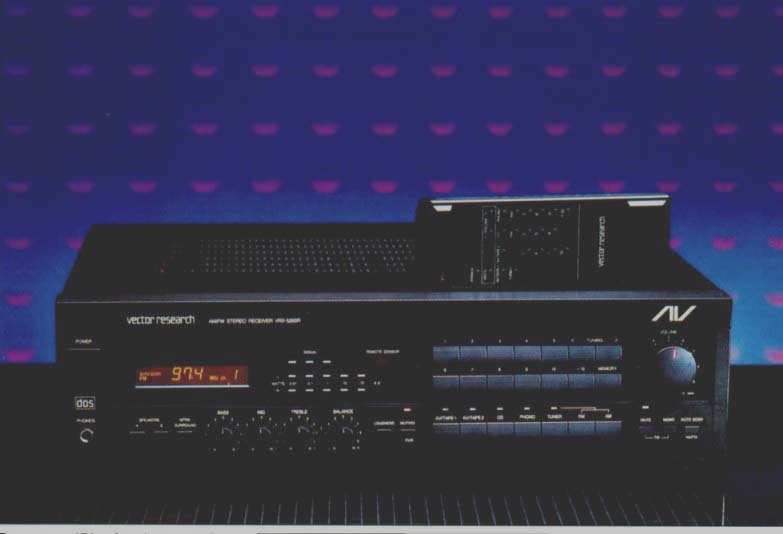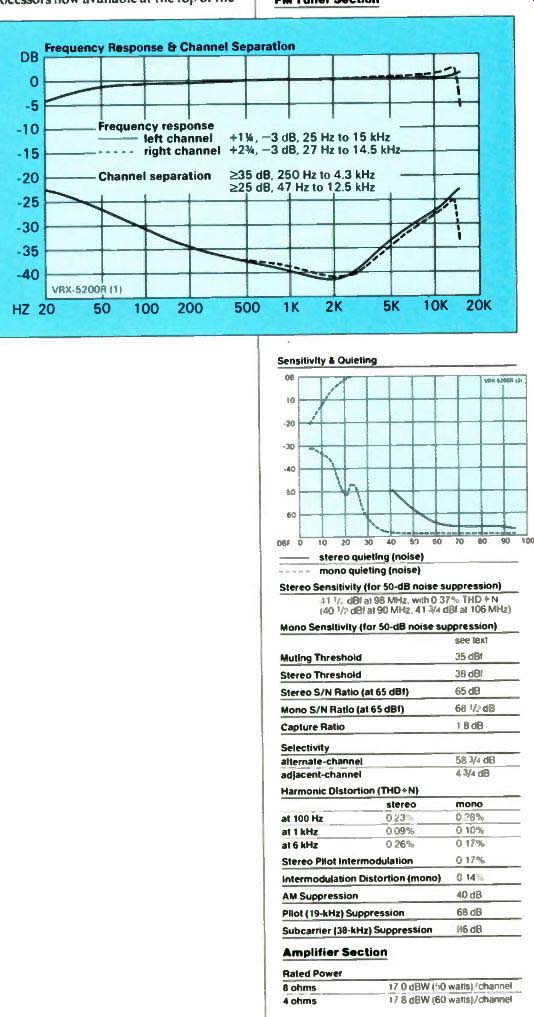Dimensions: 17 by 4 3/4 inch front, 12 in deep, plus clearance lot controls and connections. AC Convenience Outlets: One switched (100 watts max.), one unswitched (200 watts max.). Price: $370 Warranty: 'Limited,- two year parts and labor. Manufacturer: Made in Korea for Vector Research, Inc 1230 Calle Suerte, Camarillo, Calif . 93010 USA.
Vector is one of those companies that designs its own products but, to keep costs competitive, has them built overseas. Such components can be free of the fads that overtake other markets and responsive to the needs and wishes of the U.S. consumer, yet their value can be higher than could be achieved with domestic manufacture.

These virtues are clearly evident in the Vector VRX-5200R, whose price is actually lower than I would expect for a competing Japanese product. More elaborate approaches to audio-video receivers admittedly offer more flexibility for some strength is below the muting threshold. Manual tuning is the default mode. Many tuners leave you in the last-used mode, no matter what; when you press a preset on the 5200, however, it automatically puts you in manual tuning so that, unless you've deliberately set the receiver to the scan mode, the next time you press the UP or DOWN buttons the tuner won't go skittering off in search of a receivable station. This is, perhaps, an exceedingly small point, but one that I find I appreciate. Incidentally, manual tuning proceeds by half-channel (0.1-MHz) steps on FM; on AM, where the scan applications, but Vector has put its flexibility where it really counts: The logic controlling the design is exceptionally direct and clear-headed.
There are, for example, 20 radio presets, accessible via a keypad with buttons numbered 1 to 10, plus an eleventh that adds 10 to the selected number. Each preset will hold one station--AM or FM, as you choose -so you can apportion the presets however you want. In FM tuning, you can also switch independently to mono reception and interstation muting; the usual single-button de sign forces you to listen in mono if you want to hear any station whose signal mode does not apply, it's in full-channel (10-kHz) steps.
There is a three-LED signal-strength "meter" to help you orient an antenna.
Normally, three steps would be pretty meager for that purpose, but Vector has maximized their usefulness by canny de sign. The thresholds are in the most critical range (at about 36, 40, and 44 dBf--where significant audible improvement can be achieved by the right antenna orientation) and they light gradually, as signal strength rises above these thresholds.
The meter won't help you distinguish be tween good and excellent (say, in the 50 dBf range), but it does supply in formation that is more useful than that from many designs employing four or five LEDs.
The back panel has provision for 75 ohm coaxial FM connectors (a threaded F connector), 300-ohm twinlead, long wire AM antenna and ground or, alternatively, the supplied 150-ohm AM loopstick. These last attach to a row of light-duty binding posts that also include an option for a 75-ohm co-ax FM lead, should you want to dispense with the F connector. Connections for two speaker pairs are relatively lightweight spring clips. The signal connections are pin jacks with the standard coding: white and red for the two audio channels, yellow for composite video.
The approach to signal selection and routing is, at once, exceedingly simple and quite sophisticated. There are selectors for AM and FM (the tuner section), phono, CD, AV/Tape 1, and AV/Tape 2. All but the tuner are represented by back-panel connections. In addition, there are jumpered jacks for signal-processor out and in, and for pre-out and main-in. The two sets of tape connections and the processor loop have composite-video jacks (pin connectors) as well as audio jacks; there's a video-monitor output as well.
The processor loop is electrically wired into both the dubbing path and the monitoring output. It thus can be used to alter audio or video signals during dubbing, which can occur in either direction between Tape 1 and Tape 2. (The switching evidently defeats a source feed to the source deck, since there is no feedback when you switch to this illogical configuration.) There are no dubbing or monitoring controls as such. If you have a three head deck, you can attach it in the processor loop (perhaps even out-boarded from, say, an equalizer) and use the deck's monitor switch to check signal quality off the tape during recording.
You may consider this an awkward approach to three-head monitoring, but then we're not talking luxury goods here.
Similarly, you may have to do some jury rigging if you want to receive or record FM/TV simulcasts. But I don't see this as a long-term problem, because I hope that MTS stereo and improved TV audio practices will make simulcasts obsolete in the near future.
One particularly creative touch in the design--and one so logical that I am astonished it doesn't appear more frequently--is the matrix switch that converts the B speaker pair to the back channels of a surround setup. Again, this isn't a luxury unit, and the decoding circuitry (providing a channel-difference signal) is very simple by comparison with the Dolby Surround and similar processors now available at the top of the price scale. There isn't even any built-in means of adjusting front/back balance.
But the effect is available, is pleasant, and may add to your enjoyment of both music and video soundtracks.
Also useful is the inclusion of a mid range control, in addition to those for bass and treble, that makes the tone-control section essentially a three-band equalizer. In fact, the only feature of the 5200 that I consider poorly chosen is the power meter. If you like to know roughly (very roughly) how much current is being dumped into your speakers and don't mind flashing lights, you'll disagree with me on this. Obviously, many users --or, at least, designers--do.
-------------

Test Reports
--------
FM Tuner Section
Stereo Pilot Intermodulation 0 17%
Intermodulation Distortion (mono) 014%
AM Suppression 40 dB Pilot (19-kHz)
Suppression 68 dB Subcarrier (38-kHz)
Suppression 86 dB Amplifier Section
Rated Power 8 ohms 4 ohms 170 dBW (50 watts)/channel 17 8 dBW (60 watts)/channel
----------------------
The supplied wireless remote, which runs on two AAA cells, includes major functions only: AC power, source selection (including tuner presets), "mute" (a 20-dB attenuator), and volume up and down. The rotary volume control on the 5200 is motorized, and the calibration mark on the knob (which lets you see how it's set from across the room) is actually the power pilot light, appearing in red when the set is on.
The receiver's moderate power rating (50 watts, or 17 dBW, per channel) is exceeded comfortably in both the sine wave and dynamic tests, and its dynamic headroom of 2 dB or better is, in fact, above par even for pricier gear. But the alacrity with which the protection circuitry kicks in with a 2-ohm load suggests that very low speaker impedances should be avoided; the lab was unable to get useful measurements at 2 ohms. Distortion figures are not particularly low, but they aren't high enough to be of concern--a statement that might apply just as well to the amplifier's output impedance.
Overall frequency response is similarly good: within V, dB of flat across the audio band. The loudness-compensation control, which is essentially unaffected by level, adds boosts of about 9 dB below 50 Hz and of 6 dB above 10 kHz (relative to the response in the 1-kHz range). The tone controls are unusually well behaved. Approximate adjustment ranges are ±10 dB at 10 kHz for the treble, ±9 dB at 1 kHz for the midrange, and ±15 dB at 20 Hz for the bass. The midrange is broader in its frequency "reach" than is the treble; the bass also is quite broad, but (assuming relatively symmetrical effect, like the other two controls) about half of its adjustment range is below 20 Hz.
-----
ABOUT THE dBW
We currently are expressing power in terms of dB W-meaning power in dB with a reference (0 dB W) of I watt. The conversion table will enable you to use the advantages of dB W in comparing these products to others for which you have no dB W figures.
WATTS
Judging from Diversified Science Laboratories' findings, the phono section includes a nondefeatable and fairly gentle infrasonic filter that begins to attenuate response below 100 Hz and is down 3 dB at 18 Hz and about 16 dB at 5 Hz (the middle of the warp-frequency region). This certainly offers significant help with warps, but not without a slight cost to response in the audible range, which also exhibits a rise of a bit over 1 dB in the range around 7 kHz. Phono overload was measured at 105 milli volts -a satisfactory, if not overgenerous figure. Usually the measurement is made at clipping; here distortion rose gradually (and asymmetrically), so the measurement was made at 1 percent THD+N (harmonic distortion and noise). Overall, this is good, though not outstanding, phono performance.
Regular readers will note that we now graph output level for home tuners the same way we do for car radios. Paradoxically, this is the first time, as well, for the kind of anomaly that showed up in the 5200's mono quieting curve. Net signal-to-noise ratio reaches 50 dB (the sensitivity rating point) at 21 dBf but then degrades to 461 / 4 dB at 23 dBf. It achieves 50 dB again at about 2 5/ 2 dBf.
Perhaps this worse-case figure is the only legitimate reading for the test sample, though it does hover around the rating point over a uniquely wide range. Be sides, if you wish to receive only strong local stations, this low-signal behavior is irrelevant.
But even including this anomaly (for which we have no explanation), measured performance is more than accept able, given the price range. I did think the sound perhaps a shade crisper and more alive than with most tuners of com parable test results, but my area broad casters may have been on their best behavior during the trial period. The AM section stuck me as average for a receiver: firmly focused on quiet reception of strong local stations.
The most enjoyable factor in the tuner section--as in the entire receiver - was the way in which Vector has re thought conventional priorities. No other receiver I have worked with in recent memory will switch between AM and FM with the presets alone (usually, you have to switch band first, then choose the preset), and the directness of this approach is as delightful as it is rare. Even better is the tape/processor switching, which I found exceptionally efficient for audio-only use and above average even with video. Admittedly, video takes a backseat to audio in this design, but that is precisely what keeps it so logical and functional--and so inexpensive for what it offers. Add to this the generally good audio performance and the convenience of the remote control and I suspect that Vector has a hit on its hands.
Robert Long
-------------
Also see:
Cambridge Audio CD-2 Compact Disc player (review, Oct. 1988)